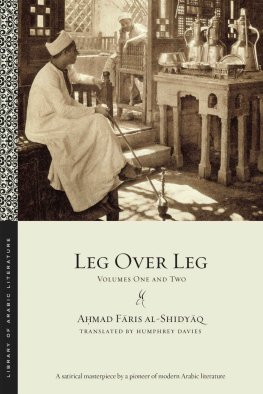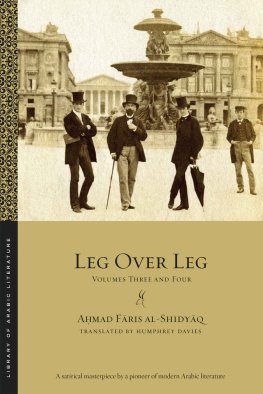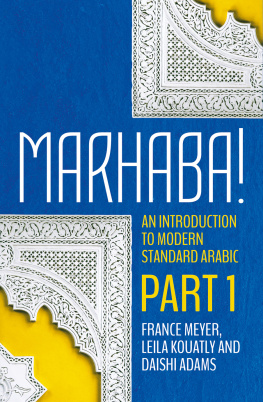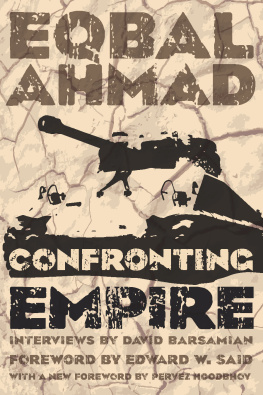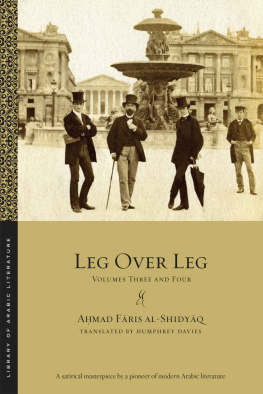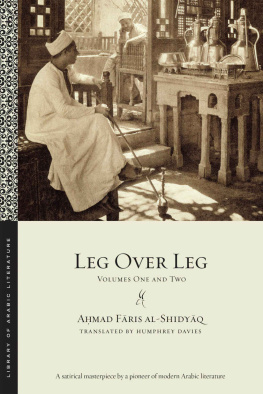Ahmad Faris al-Shidyaq
Leg over Leg: Volumes One and Two
LETTER FROM THE GENERAL EDITOR

The Library of Arabic Literature series offers Arabic editions and English translations of significant works of Arabic literature, with an emphasis on the seventh to nineteenth centuries. The Library of Arabic Literature thus includes texts from the pre-Islamic era to the cusp of the modern period, and encompasses a wide range of genres, including poetry, poetics, fiction, religion, philosophy, law, science, history, and historiography.
Books in the series are edited and translated by internationally recognized scholars and are published in parallel-text format with Arabic and English on facing pages, and are also made available as English-only paperbacks.
The Library encourages scholars to produce authoritative, though not necessarily critical, Arabic editions, accompanied by modern, lucid English translations. Its ultimate goal is to introduce the rich, largely untapped Arabic literary heritage to both a general audience of readers as well as to scholars and students.
The Library of Arabic Literature is supported by a grant from the New York University Abu Dhabi Institute and is published by NYU Press.
Philip F. Kennedy
General Editor, Library of Arabic Literature
This paperback edition differs in a few respects from its dual-language hard-cover predecessor. Because of the compact trim size the pagination has changed, but paragraph numbering has been retained to facilitate cross-referencing with the hardcover. Material that referred to the Arabic edition has been updated to reflect the English-only format, and other material has been corrected and updated where appropriate. For information about the Arabic edition on which this English translation is based and about how the LAL Arabic text was established, readers are referred to the hardcover.
LEG OVER LEG: VOLUMES ONE AND TWO
NEW YORK UNIVERSITY PRESS
New York and London
Copyright 2015 by New York University
All rights reserved
Library of Congress Cataloging-in-Publication Data
Shidyaq, Ahmad Faris, 1804?-1887.
Leg over leg or The turtle in the tree concerning the Fariyaq: what manner of creature might he be / by Faris al-Shidyaq; edited and translated by Humphrey Davies.
volume cm (Library of Arabic literature)
Includes bibliographical references and index.
ISBN 978-1-4798-0072-8 (vols. 12: ppk: alk. paper) ISBN 978-1-4798-1329-2 (vols. 34: ppk: alk. paper) ISBN 978-1-4798-3288-0 (ebook) ISBN 978-1-4798-8881-8 (ebook)
1. Shidyaq, Ahmad Faris, 1804?-1887. 2. Shidyaq, Ahmad Faris, 1804?-1887Travel Middle East. 3. Arabic language Lexicography. 4. Middle East Description and travel. I. Davies, Humphrey T. (Humphrey Taman) translator, editor. II. Shidyaq, Ahmad Faris, 1804?-1887. Saq ala al-saq. III. Shidyaq, Ahmad Faris, 1804?-1887. Saq ala al-saq. English. IV. Title. V. Title: Turtle in the tree.
PJ7862.H48S213 2015
892.78503dc23 2015021915
New York University Press books are printed on acid-free paper, and their binding materials are chosen for strength and durability.
Series design and composition by Nicole Hayward
Typeset in Adobe Text
Manufactured in the United States of America
10 9 8 7 6 5 4 3 2 1
FOREWORD REBECCA C. JOHNSON
While I do not claim to be the first writer in the world to follow this path or thrust a pinch of it up the noses of those who pretend they are dozing, I do notice that all the authors in my bookcase are shackled to a single stylistic chain. . Once youve become familiar with one link of the chain, you feel as though you know all the others, so that each one of them may truly be called a chain-man, given that each has followed in the footsteps of the rest and imitated them closely. This being established, know that I have exited the chain, for I am no chain-man and will not form the rump of the line; nor do I have any desire to be at its front, for the latter is an even more calamitous place to be than the former.
Leg over Leg (1.17.10)
For most Anglophone readers, this will be their first introduction to the writing of Fris al-Shidyq (later Amad Fris al-Shidyq, born in 1805 or 1806 and died in 1887), a foundational figure in Arabic literary modernity.1 For, although he is the author of at least four published works of literary prose, ten linguistic studies of Arabic, Turkish, English, and French, over 20,000 lines of poetry, and at least four unpublished manuscripts (not to mention his many translations, journalistic and critical essays, or those works that have been lost), his work has never appeared in English until now. For specialists in Arabic literature and many native readers of Arabic, however, he needs little introduction. As belletrist, poet, travel writer, translator, lexicographer, grammarian, literary historian, essayist, publisher, and newspaper editor, he is known as a pioneer of modern Arabic literature, a reviver of classical forms, the father of Arabic journalism, and no less than a modernizer of the Arabic language itself. His masterwork, Al-Sq al l-sq f m huwa al-Friyq (Leg over Leg or the Turtle in the Tree concerning the Friyq, What Manner of Creature Might He Be, 1855), is acknowledged as one of the most distinguished works of the nineteenth century and an inaugural text of Arab modernity. It is also among the most controversial: generically impossible to characterize, it is a critical, self-referential, learned, and irreverent book of observations on the lives and manners of The Arabs and their Non-Arab Peers that includes scathing attacks on authority, both ecclesiastical and worldly, as well as liberal and libertine discussions of relations between the sexes.
Yet, while virtually all studies of Arabic literature acknowledge his central place in literary history, the works of al-Shidyq, as Nadia Al-Bagdadi writes, have largely been merely read, but not seriously known in Arabophone and Anglo-European academies alike.2 Although a growing number of essays on his work has been published in English, no monograph on his work has yet been written, and, although several biographies and studies exist in Arabic, his oeuvre was still so little known in 1995 that an edited volume of his selected works could be published in a series entitled Unknown Works.3Leg over Leg itself has been seldom reprinted and often abridged (as often for moral as for aesthetic reasons), making a thorough study of its contents difficult. Moreover, it has suffered from more general scholarly neglect, as the nineteenth century has, until recently, remained one of the lesser-studied periods of Arabic literature. Known as the Nahah, a term derived from the verb meaning to rise or to stand up, it is commonly translated as the awakening or revival of Arabic literary culture a flowering often attributed to the salutary influence of European culture, for which reason it has also been called the Arab rediscovery of Europe, beginning with Napoleons invasion of Egypt in 1798.4 Following a clearly Eurocentric paradigm, scholarship has tended for many years to emphasize the innovative aspects of the period most notably the introduction of European genres and styles and to sideline works following classical models, as well as works that fall between the two. Works such as Leg over Leg have been overlooked by those scholars who have seen it as a transitional curiosity between the intellectually frivolous and decadent post-classical literary age and the twentieth-century flowering of the modern novel.5

